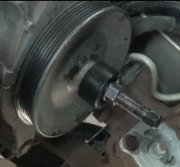You're confusing "leak" with "burned out". Those are two totally different things. I only mentioned the leaking rack and pinion assembly because that is more common than a leaking pump. The pump is cooled by the fluid, so if there is a leak anywhere in the system and the fluid level gets too low, THAT is what can cause a pump to burn out. That won't happen right away. It can take up to many hours of driving it like that but wear is taking place when you do.
The point of my story was to give you all of the possibilities of what can leak in the power steering system. There are only four parts to look at. You have to find the highest place you see fluid because it doesn't run up, only down, but if it hits the pulley it can be sprayed all over. The pump will only leak on the passenger side and there will likely be fluid sprayed onto the bottom of the hood. From there it will drip onto the ground near the right, (passenger side) tire. Since it's starting up high, the fluid can also run along hoses and brackets and drip onto the ground in other areas. That's why you have to look for the highest spot you find wetness.
The rack and pinion can leak from three places. The least common is where the steering column goes through the firewall right above your brake pedal. That leak can often result in power steering fluid running inside the car onto the floor. The two more common points to leak are on either end under rubber boots that look like accordions. Those boots are only meant to keep dirt out. When the seals start to leak, the fluid fills those boots up first, then when they get full, the fluid starts to get forced out and the leak shows up. If you drain those boots, the leak might not show up again for days or weeks but the leak is still there. Both boots will fill with fluid at the same time. You never know which one the fluid will leak from first. The puddle will show up on the ground about a foot from the back of one of the front tires. If it's on the left, (driver's) side, it can only be from the rack and pinion assembly. If it is on the right side, you have to look to see how high up there is wetness. If the pump is dry, the rack is leaking. If the pump is wet, and especially if fluid has been sprayed onto the hood, the pump is leaking. It is always possible both the pump and rack are leaking at the same time, but that is about as likely to happen as blowing out two tires at the same time. Possible, but not likely.
Here's a real good clue if the rack is leaking. The fluid level will go down so far that the pump draws in air and makes a loud buzzing sound, worse when you turn the steering wheel. There's no apparent leak so you fill the fluid and once the air has bled out, the power steering works fine again for days or weeks. What's happening is the fluid is leaking out but is being caught in those accordion boots so you don't SEE it, ... Yet. Once the boots fill up with about a quart or two of fluid, pressure will build up and force the fluid out where it leaks onto the ground. Besides the location of the puddle, the clue was the low fluid level days or weeks earlier. The pump, pulley, and hood will all be dry.
The last two things that can leak are the two hoses. Fluid can seep from a split in the rubber hose or where the rubber hose is crimped to the metal fittings on each end. This typically happens to the high pressure hose that sends fluid from the pump to the rack. The fluid can spray onto other areas, and it can run onto the frame of the car and go to either side. The puddle on the ground can be anywhere between the two front tires and will usually be only a few inches from front to rear but over two feet wide. The pressure in that hose can exceed 1100 psi so the fluid can spray all over. There is no pressure in the return hose so it doesn't use those special fittings. In fact, the rubber hose just slides onto a metal pipe and a simple spring-metal clamp holds it from sliding off. About the only thing that could happen to him is it slides off a metal tube on one end. That will cause all the fluid to run out within a few seconds. There will be no driving for days or weeks when that hose is disconnected.
So, the bottom line is again to determine exactly where the fluid is leaking from. Look for the highest spot where you find wetness. You can use brake parts cleaner or engine degreaser from a spray can to clean and dry off suspect areas, then watch for fluid leaking out while the engine is running. (Wear safety glasses around the pump when it's running in case the pulley is spraying fluid).
Wednesday, April 13th, 2011 AT 2:50 AM


